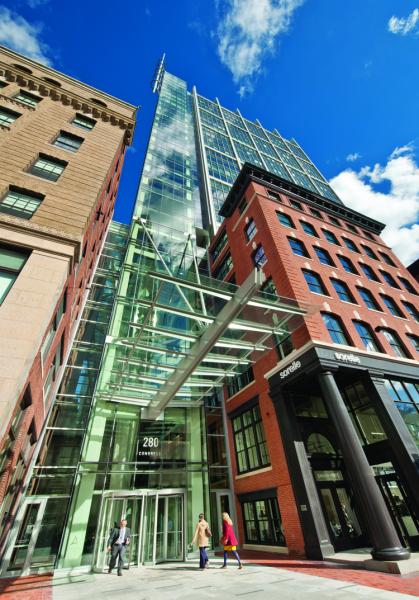 Atlantic Wharf, a mixed-use project by Massachusetts-based Boston Properties, is a unique mix of new and old—the development of a sustainable and modern project that preserves historic structures and integrates new development into a distinctive structure on Boston’s waterfront.
Atlantic Wharf, a mixed-use project by Massachusetts-based Boston Properties, is a unique mix of new and old—the development of a sustainable and modern project that preserves historic structures and integrates new development into a distinctive structure on Boston’s waterfront.
“There were two historic properties on the site that were very meaningful to the city of Boston. The existing front structure, called the Russia Building, was retained since it dates back to the 1700s and the Boston Tea Party took place behind the building,” says Bryan Koop, senior vice president and regional manager for Boston Properties. “Boston Properties transformed the Russia Building (1899) into lofts and preserved the facades of the Graphic Arts and Tufts Building (1897) so the streetscape was unchanged, but the interior was enhanced and restored.”
Boston Properties was honored with the 2012 NAIOP Sustainable Development Award for Atlantic Wharf, and the project was awarded LEED Platinum certification for its unique green design and construction features.
Acquired in March 2007, Boston Properties first undertook a structural and architectural redesign of the 553,000-sq.-ft. tower portion to create more efficient, essentially column-free, leasing-friendly floor plates. To persevere during the recession that began in 2008, Boston Properties converted approximately 223,000 sq. ft. of residential space to offices, today called the Waterfront Office component, with an additional 25,600 sq. ft. of residential space converted to retail space on Floor 1.
The development’s sustainable advantages for this 31-story urban infill brownfield redevelopment are countless, including a rain harvesting system that catches and reuses rainwater.
“The rain is stored, used, cleaned and emitted back into the environment, cleaner than when we captured it,” says Koop. “A second unique feature is the green roof. Boston Properties installed a new type of grid system that allowed the pre-growth of the plant species on the grids and, once construction was completed, the species were added to the roof. More importantly, if there are ever any leaks, the grids can be taken apart, the leaks found and the system put back together.”
More than 95 percent of waste generated from the project was diverted from landfills, and the materials utilized in the construction included more than 30 percent recycled content. One hundred percent of the metal waste (structural steel) removed from the site was recycled or reused. Of the concrete, brick and block waste generated from the demolition and construction, 100 percent of that which was not reused on site was recycled.
Boston Properties says that Atlantic Wharf is designed to use 42 percent less energy than comparable New England office buildings, and noteworthy measures include an improved thermal envelope, high-efficiency glazing, a high-efficiency boiler and garage ventilation controls.
The core and shell portion of the project controls approximately 67 percent of annual energy use, while the tenant design and operations influence the remaining 33 percent. To measure and verify the energy savings, tenant sub-metering was implemented.
In real estate, location is still everything. The property is located less than a half mile from two public transportation stations, providing easy access to all lines in the MBTA subway system. For pedestrians, the property contains an on-site connection to Boston’s public HarborWalk. The property includes vegetated open space equal to 34 percent of the property’s site area. The property includes 16,000 sq. ft. of interior spaces open to the public for community events.
Kathryn Hamilton is vice president of marketing and communications at the National Association of Industrial and Office Properties (NAIOP) and a member of NREI's Sustainability Board of Advisors.

